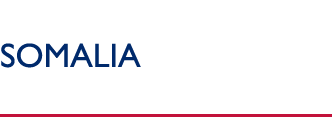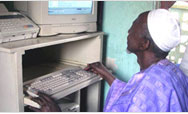 |
 |
|
 |
 |
|
 |
 |
|
 |
 |
 |
USAID Information:
External Links:
|
|
 |
 |
|
Somalia – Complex Emergency
October 08, 2008
Situation Report #1, Fiscal Year (FY) 2009 (PDF, 50kb)
Map (PDF, 281kb)
Background
Since 1991, widespread violence, endemic poverty, and recurrent droughts, and floods have generated a complex
emergency in Somalia. Continued civil strife and inter-clan conflicts have complicated the humanitarian situation and
limited access to affected areas. In addition, ongoing fighting since late December 2006 between the Somalia
Transitional Federal Government (TFG), Ethiopian forces, and armed militias opposed to the TFG has led to a further
deterioration in humanitarian conditions. As a result, approximately 476,000 Somali refugees have fled the country
and more than 1.1 million internally displaced persons (IDPs) are uprooted within Somalia, including long-term IDPs as
well as individuals displaced by increased fighting since February 2007.
In August 2008, the U.N. Food and Agriculture Organization (FAO) Food Security Analysis Unit (FSAU) reported that
3.2 million people are in need of humanitarian assistance, a 77 percent increase since January 2008. The combined
effects of consecutive seasons of failed or poor rainfall, continuing conflict, rising inflation, massive displacement, and
diarrheal disease outbreaks have severely exacerbated the food security situation and resulted in a significant increase in
acute malnutrition rates, according to the 2008 U.N. Consolidated Appeals Process (CAP) for Somalia. U.N. and
partner agencies are coordinating efforts to improve access, but insecurity and targeted attacks against relief staff hinder
the provision of emergency assistance to affected populations.
On October 3, 2007, U.S. Ambassador to Kenya Michael E. Ranneberger redeclared a disaster due to the ongoing
complex emergency in Somalia. In FY 2008, the U.S. Government (USG) has provided nearly $269 million for
emergency food assistance, health, nutrition, agriculture and food security, livelihoods support, humanitarian
coordination, protection, and water, sanitation, and hygiene programs, as well as refugee assistance and air operations.
NUMBERS AT A GLANCE
| Total Population in Need of Emergency Assistance |
3.2 million |
FSAU – Aug. 2008 |
| Urban Caseload |
705,000 |
FSAU – Aug. 2008 |
| IDPs since February 2007 |
870,000 |
FSAU – Aug. 2008 |
| Long-Term IDPs |
275,000 |
FSAU – Aug. 2008 |
| Rural Caseload |
1,395,000 |
FSAU – Aug. 2008 |
| Somali Refugees in Djibouti, Kenya, Ethiopia, and Yemen |
334,000 |
UNHCR(1) Global Trends Report – June 2008 |
|
FY 2008 HUMANITARIAN FUNDING
| USAID/OFDA Humanitarian Assistance to Somalia: |
$51,202,443 |
| USAID/FFP (2) Humanitarian Assistance to Somalia: |
$197,398,000 |
| State/PRM (3) Humanitarian Assistance to Somalia: |
$21,850,000 |
| Total USAID and State Humanitarian Assistance to Somalia: |
$270,450,443 |
|
|
|
|
Current Situation
The collective impact of rising food and fuel prices,
drought conditions, and widespread insecurity
continues to exacerbate food insecurity and
malnutrition levels in Somalia. According to FSAU,
3.2 million people, or 43 percent of the total population
of Somalia, are in need of emergency humanitarian
assistance, representing a 77 percent increase since
January 2008. The most affected populations include
rural populations in southern and central Somalia.
However, the USAID-supported Famine Early
Warning Systems Network (FEWS NET) also notes
that new areas of Somalia are now confronting high
levels of food insecurity, including Sool, Nugal, and
Togdheer regions north Somalia.
In addition, targeted attacks against humanitarian
workers and renewed fighting in Mogadishu are
negatively affecting response efforts and resulting in
new displacement, including in Mogadishu and Bay
and Bakool regions. Despite restrictions due to
insecurity and violence, humanitarian agencies
continue to provide critical humanitarian assistance to
drought- and conflict-affected populations throughout
Somalia.
On September 30, the Horn of Africa Response
management Team (RMT) based in Washington and
the Disaster Assistance Response Team (DART) based
in Nairobi, Kenya, stood down and reverted coverage
of the regional food security crisis to the Regional
Team and East and Central Africa Regional Office
(ECARO). However, USAID/OFDA staff continue to
monitor conditions and address evolving needs related
to the regional drought and food security crisis, in
addition to facilitating coordination and information
sharing among international relief organizations.
Security and Population Movements
Insecurity, renewed fighting, and the continued
targeting of humanitarian staff and operations are
impeding the provision of humanitarian relief
throughout Somalia and contributing to significant
population displacement.
Since September 21, intense fighting between armed
insurgents and African Union Mission in Somalia
(AMISOM) forces has displaced an estimated 37,000
people and closed the main market in the capital,
according to UNHCR. The majority of newly
displaced persons have fled to other parts of the capital
and are in need of shelter and food assistance,
according to OCHA. Recent insecurity has contributed
to the displacement of more than 68,000 IDPs in
Mogadishu since July. According to FSAU, more than
1.1 million people are currently displaced in Somalia.
In addition, UNHCR reports that an average of 5,000
refugees from Somalia arrive at Dadaab refugee camp
in the North Eastern Province of Kenya each month.
Since January 2008, more than 43,000 Somalia
refugees have registered at the camp. Intended to
accommodate 90,000 refugees, the camp now hosts
approximately 215,000 people. Negotiations are
ongoing between UNHCR and Kenyan government to
secure additional land for the construction of a new
camp to meet the expanded refugee population needs.
In FY08, State/PRM provided a total of $32.5 million
for assistance programs targeting Somali refugees in
Kenya, Ethiopia, Djibouti, and Yemen, representing an
increase of 170 percent from FY 2007.
To date in 2008, OCHA has reported more than 110
security incidents involving humanitarian staff or
assets in Somalia, including the deaths of 24 aid
workers. Recent incidents include the abduction of
humanitarian staff and looting of food assistance
commodities. On September 25, unknown assailants
ambushed a convoy of 35 trucks carrying 1,230 metric
tons (MT) of U.N. World Food Program (WFP)
emergency food aid to Hudur and Tieglow districts,
Bakool Region, valued at approximately $700,000.
Health and Nutrition
FEWS NET continues to highlight escalating nutrition
concerns among vulnerable, drought-affected, and
displaced populations. On September 10, FEWS NET
reported that an estimated 180,000 children residing in
southern and central Somalia and IDP camps
throughout the country are acutely malnourished,
including 26,000 children that are severely
malnourished and in need of immediate assistance.
In response, USAID/OFDA implementing partner the
U.N. Children's Fund (UNICEF) is supporting two
supplementary feeding centers, five out-patient
therapeutic centers, and two stabilization centers in
Mogadishu that treat an average of 1,400 moderately
malnourished and 1,800 severely malnourished
children monthly. In addition, UNICEF is providing
supplementary food assistance to approximately 10,000
children under the age of five residing in IDP camps in
northern Mogadishu each month.
In the context of high and increasing levels of acute
malnutrition, humanitarian organizations note
increased concern for a potential measles outbreak and
its impact on vulnerable populations. As part of a child
health campaign targeting an estimated 1.5 million
children under the age of five, UNICEF vaccinated
more than 140,000 children between the age of nine
months and 15 years against measles in IDP
settlements in Mogadishu, Banadir Region, and
Afgooye, Lower Shabelle Region, during September,
according to OCHA.
In FY 2008, USAID/OFDA provided nearly $9.4
million for nutrition activities in Somalia, including
more than $4.1 million to UNICEF to support nutrition
programs in Mogadishu and Lower Shabelle Region.
Emergency Food Assistance
According to the U.N., inadequate funding, pipeline
breaks, and restricted humanitarian access resulted in
significant disruptions to WFP and CARE food
assistance distributions in the month of August,
including the cessation of CARE distributions and
reduced WFP distributions. In August, WFP
distributed rations to only 54 percent of 900,000
targeted beneficiaries. In addition, WFP reports a $98
million shortfall for emergency food assistance to meet
projected food needs from October 2008 through
March 2009.
Despite challenges, WFP continues to provide daily
cooked rations to an average of 80,000 people from 16
facilities in Mogadishu, representing predominantly
women and children. In addition, food aid
organizations distributed monthly food rations to
nearly 3 million beneficiaries in the month of
September, according to WFP.
Incidences of piracy off the coast of Somalia continue
to impede commercial transport and underscore the
need for naval escorts to ensure the delivery of critical
humanitarian food assistance. On September 25 and
18, pirates hijacked a Ukrainian and Greek vesse1 in
Somali waters, respectively, bringing the total number
of hijacked ships and/or attempted hijackings in 2008
to more than 60.
On September 23, the Government of Canada (GOC)
confirmed an extension of GOC naval escorts for WFP
shipments of emergency relief commodities to Somalia
from September 27 until October 23. Since August 18,
the GOC has escorted five WFP-contracted vessels to
Mogadishu transporting a total of 36,360 MT of
assorted food commodities, including 13,770 MT of
maize delivered on September 27. However, WFP has
not been able to secure a replacement for the GOC
naval escort to ensure delivery of the approximately 90
percent of WFP food assistance transported to Somalia
by sea. WFP reports that an additional 150,000 MT of
food assistance is scheduled to be delivered to Somalia
between October and December 2008. On September
15, the European Union agreed to establish a
coordination unit in Brussels to support European
surveillance activities off the Somali coast as part of an
anti-piracy security operation scheduled to begin
November. In addition, the USG continues to
coordinate with international partners on potential
counter-piracy efforts and to secure long-term naval
escorts for WFP humanitarian shipments to Somalia.
In FY 2008, USAID/OFDA committed more than $20
million for the regional purchase of 26,107 MT of
maize to support WFP food aid operations targeting an
estimated 2 million beneficiaries.
USAID/FFP provided more than 211,000 MT of P.L.
480 Title II emergency food assistance, valued at more
than $197 million, in FY 2008. In total, USAID/FFP
assistance benefits approximately 1.7 million Somalis
countrywide.
Water, Sanitation, and Hygiene
Since August 2008, the U.N World Health
Organization (WHO) has reported 329 cases of acute
watery diarrhea (AWD) in Lower Shabelle Region,
including 22 laboratory-confirmed cases of cholera and
four deaths of children under five years of age. Since
the establishment of WHO's Early Warning and
Response System (EWARS) in May, WHO has
reported a total of 5,725 AWD cases, including 25
deaths in the region. The highest concentration of
reported cases occurred in Marka District, accounting
for 54 percent of the total caseload and 68 percent of
total related deaths.
Nearly $9 million in FY 2008 USAID/OFDA funding
supports water, sanitation, and hygiene interventions
countrywide, including Mercy Corps programs in
Lower Shabelle Region.
For detailed information on U.S. Government humanitarian assistance to Somalia, please see Situation Report #1, Fiscal Year (FY) 2009 (PDF, 50kb)
Back to Top ^
|


